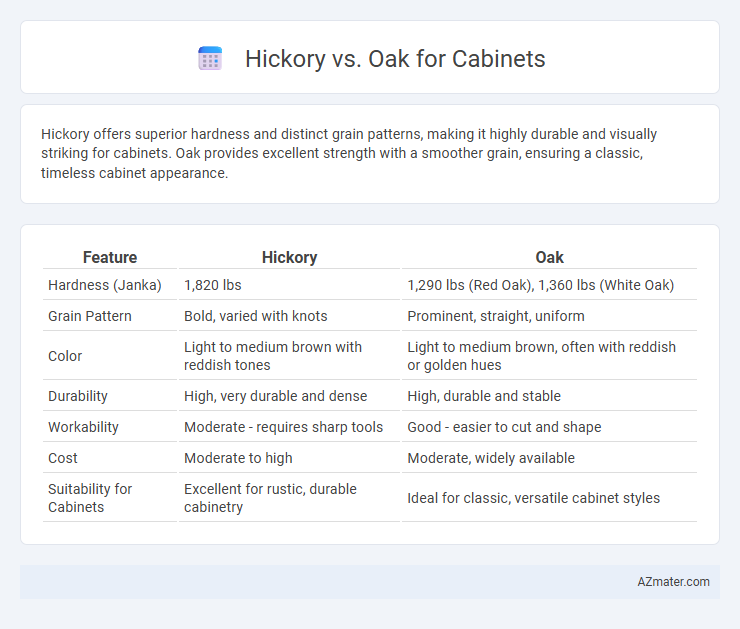Hickory offers superior hardness and distinct grain patterns, making it highly durable and visually striking for cabinets. Oak provides excellent strength with a smoother grain, ensuring a classic, timeless cabinet appearance.
Table of Comparison
| Feature | Hickory | Oak |
|---|---|---|
| Hardness (Janka) | 1,820 lbs | 1,290 lbs (Red Oak), 1,360 lbs (White Oak) |
| Grain Pattern | Bold, varied with knots | Prominent, straight, uniform |
| Color | Light to medium brown with reddish tones | Light to medium brown, often with reddish or golden hues |
| Durability | High, very durable and dense | High, durable and stable |
| Workability | Moderate - requires sharp tools | Good - easier to cut and shape |
| Cost | Moderate to high | Moderate, widely available |
| Suitability for Cabinets | Excellent for rustic, durable cabinetry | Ideal for classic, versatile cabinet styles |
Introduction: Hickory vs Oak Cabinets
Hickory cabinets offer a distinctive look with their natural variations in color and grain, providing durability and hardness that ranks high on the Janka scale. Oak cabinets, known for their classic grain patterns and warm tones, deliver strength and a timeless appeal widely favored in traditional and modern kitchen designs. Both woods provide excellent cabinet options, but hickory's rugged texture contrasts with oak's smoother, more uniform finish, influencing the overall kitchen aesthetic.
Wood Characteristics: Hickory and Oak Compared
Hickory wood is known for its exceptional hardness and durability, featuring a strong grain pattern with varied color tones from creamy white to rich brown, making it highly resistant to wear and dents. Oak offers a dense, sturdy structure with a more uniform grain that ranges from light to medium brown, providing excellent stability and a classic look often favored in cabinetry. Both woods are popular in cabinet making for their strength, but hickory's bold texture contrasts with oak's smoother, more consistent appearance.
Appearance and Grain Differences
Hickory cabinets showcase a distinctive appearance with dramatic color variations ranging from creamy whites to rich browns, creating a dynamic and rustic look. Oak cabinets feature a more uniform texture with a consistent grain pattern characterized by prominent rays and flecks, offering a classic and traditional aesthetic. The coarse, uneven grain of hickory contrasts sharply with oak's smoother, straight grain, making each wood type ideal for different design preferences in cabinetry.
Durability and Strength: Which Lasts Longer?
Hickory cabinets exhibit exceptional durability due to their dense grain structure and high hardness rating of 1820 on the Janka scale, making them resistant to dents and scratches. Oak, with a hardness rating around 1290 (red oak) to 1360 (white oak), offers strong, stable cabinetry but tends to be less resistant to impact than hickory. For long-lasting cabinet solutions that endure heavy use, hickory generally outperforms oak in strength and longevity.
Cost Comparison: Hickory vs Oak
Hickory cabinets typically cost between $150 and $200 per linear foot, making them a more affordable option compared to oak, which ranges from $180 to $250 per linear foot. The higher cost of oak is due to its denser grain and greater durability, contributing to longer lifespan and better resistance to dents and scratches. For budget-conscious kitchen renovations, hickory offers a cost-effective alternative without compromising on strength and aesthetic appeal.
Maintenance and Care Requirements
Hickory cabinets require regular sealing and polishing to maintain their natural color and prevent dryness due to their open-grain texture, which can absorb moisture and dirt more easily. Oak cabinets, with their denser grain and natural resistance to wear, demand less frequent maintenance but benefit from periodic cleaning and oiling to preserve their durability and rich finish. Both woods respond well to gentle cleaning agents, but oak's hardness offers better resistance to scratches, making it a practical choice for lower-maintenance cabinetry.
Suitability for Different Interior Styles
Hickory cabinets offer a rustic and knotty appearance that complements farmhouse, country, and traditional interior styles with warm, natural tones and pronounced grain patterns. Oak cabinets feature a more uniform texture and strong grain, making them suitable for classic, craftsman, and transitional designs, adding durability and timeless appeal. Both woods provide versatile options, but hickory excels in rustic charm while oak stands out in refined, traditional settings.
Environmental Impact and Sustainability
Hickory cabinets typically have a lower environmental impact due to the tree's faster growth rate and sustainable harvesting practices compared to oak, which grows more slowly and requires longer maturity periods. Oak's dense grain and widespread use often lead to higher demand, increasing deforestation concerns and transportation emissions. Both woods benefit from certifications like FSC, but choosing Hickory can support more sustainable forestry and reduce carbon footprint in cabinet production.
Pros and Cons of Hickory Cabinets
Hickory cabinets offer exceptional durability and a distinctive grain pattern that adds rustic charm and warmth to kitchen spaces. Their hardness makes them highly resistant to dents and scratches, ideal for high-traffic areas, but the dense wood can be challenging to stain evenly, sometimes resulting in color inconsistencies. While hickory's natural color variation enhances visual interest, it may not suit those seeking a uniform, polished look like oak provides.
Pros and Cons of Oak Cabinets
Oak cabinets offer exceptional durability and a classic, timeless appearance with a prominent grain pattern that enhances kitchen aesthetics. They resist dents and scratches well, making them suitable for high-traffic areas, but their hardness can make installation more challenging and costly. Oak's natural color ranges from light to medium brown, requiring careful staining to avoid an overly rustic feel, which might not suit all design preferences.

Infographic: Hickory vs Oak for Cabinet
 azmater.com
azmater.com